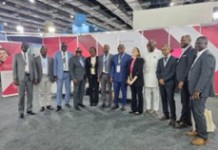By Amin Kef Sesay
During the ceremony for the launch of the Conservation Trust Fund’s strategic Plan 2021-2025 on the 18th March 2021 the European Union Ambassador to Sierra Leone, Tom Vens ,stated that the Conservation Trust Fund, together with the National Protected Area Authority, was established in 2012 to promote the conservation of biodiversity and at the same time improve the sustainable use of natural resources and the overall environmental management in the National Parks and Protected Areas.
He highlighted that Sierra Leone is endowed with considerable natural assets, which make the country so beautiful and so unique from an environmental point of view.
Tom Vens maintained that many are equally aware that the economy of Sierra Leone is almost entirely dependent on its natural resources, as the vast majority of the population rely on the exploitation of land and marine resources for employment, income generation and food production.
He said it is therefore crucial that the natural capital is preserved, in order for Sierra Leone to continue receiving the ecosystem services, such as clean water, clean air and a sustainable supply of food and energy, which make life and the life of future generations possible.
The EU Ambassador noted that it does not require a great deal of imagination to understand the effect on the supply of drinkable water to Freetown from the Guma dam, should the deforestation in the Western Area Peninsula National Park continue unchecked.
“There is also increasing evidence that balanced and sustainable ecosystems are essential to improve the resilience of the population to the adverse effects of climate change,” he stated adding that the effect of rising sea levels on the coastal communities of Sierra Leone could be catastrophic, should the destruction of the mangrove forests continue at the same rate we are experiencing today.
He said Sierra Leone has approximately 600,000 hectares of land designated as National Park or other forms of protected areas which according to him is a remarkable 9% of the total land area of the country.
“The forest cover is a direct indicator of the health status of natural landscapes, and a good proxy indicator of the human management of ecosystems,” he revealed lamenting that unfortunately, the Tree Cover index for Sierra Leone has sharply decreased over the past years.
In 2018, the Director of Environment informed the public that less than 5% of the original forests is left in the country, mainly in isolated reserves on top of mountains and hillside.
The latest national forest inventory was carried out in 1975. As a result, there is lack of scientific data on the real forest cover. However, there is sufficient and compelling evidence of widespread forest degradation, such as the case of Tonkolili forest, one of the largest primary forest of Sierra Leone, which has now been reduced to only a small and fragmented area.
A recent statement from the Ministry of Lands, Housing and Country Planning has confirmed that extended deforestation is also taking place in and around the Western Area Peninsula National Park, mainly driven by illegal construction and firewood harvesting activities.
An effective defence of the environment meanwhile starts from the national parks and other areas that are protected by law.
One of the EU’s first contributions to environmental protection in Sierra Leone was made several years ago to what today has become the Tacugama Chimpanzee Sanctuary, followed by a project for the Gola Forest in 2007.
More recently, Tom Vens said, they provided institutional support to the Environmental Protection Agency, to the National Protected Areas Authority and the Forestry Division in the Ministry of Agriculture.
He said they also supported the Reduction of Emissions from Deforestation and forest degradation programme, also called REDD+.
EU support to the Tacugama sanctuary and the Gola National Park which he pointed out can be considered as success stories, and provide a model for elsewhere.
The EU Ambassador said in particular, the Gola National Park is probably the first and only initiative in Sierra Leone that, still today, is able to raise funds from its ecosystem services by selling carbon credits to the market.
Tom Vens intimated that only a few days ago, he launched a short training course for journalists, so they can improve their contribution to the much-needed public awareness with more and better reporting on biodiversity and environmental issues.
“I am now happy to announce that our engagement will increase in the days to come, as we are planning to award a grant contract from a regional programme in support to Sierra Leone and Guinea for the trans-frontier park of Outamba Kilimi,” he revealed.
The tasks ahead, he said, are very challenging.
“Government authorities need to ensure that the legal framework for environmental protection is reviewed, updated and adequately enforced,” he suggested.
With reference to the deforestation that is taking place in the Western Peninsula Park, Tom Vens said it is plausible that if illegal and unregulated housing is prevented, the demand by the construction industry for poles and saw timber would be reduced stating that as a result, tree harvesting from the national park would also decrease.
According to him another challenge in terms of legal and regulatory framework is to ensure that all relevant institutions have clear roles and responsibilities around environmental issues, without overlapping mandates.
“Law enforcement should not be blind to the different roles played by the various actors along the supply chain, from logging to processing, transportation and final marketing, and in a way that is proportionate to the economic gains from illegal activities by the actors,” he averred.
He said law enforcement on its own may not be sufficient as there is need to ensure that local communities in and around the National Parks and Protected Areas have access to sources of income that are an alternative to the unsustainable use of natural resources.
The EU Ambassador noted that it is also essential that all relevant authorities closely collaborate with civil society organisations, especially at grassroots level, in order to mainstream environmental issues and make the population better aware that a forest that is preserved and well managed can provide much more benefits, in the medium and long term, compared that a forest that is cut down and destroyed.
He said that message is very important, especially to the young generations, and should be disseminated at very early stage of the educational cycle.
“Sierra Leone’s approach to biodiversity and environmental protection is well aligned with the European Green Deal, which lays the foundation of our external cooperation policy and which will constitute one of the main pillars of our future partnership with Sierra Leone,” he stated.
Tom Vens revealed that the design and implementation of a future European Green Deal with Sierra Leone will offer clear opportunities for a renewed dialogue and actions on environment, biodiversity and climate change.
“We are therefore ready to work together on a clear road map of interventions and a set of tangible results that could be used by all Ministries and Agencies that have the authority and responsibility over the protection of the environment, in close collaboration with civil society organisations and other development partners,” he stated.
He further said they are also ready to collaborate with the country’s quest for securing a reliable flow of financial resources, which is much needed for all the environmental programmes to be implemented successfully and in a sustainable way.






